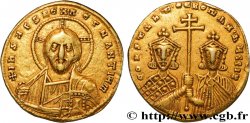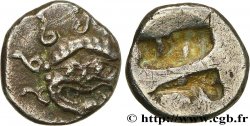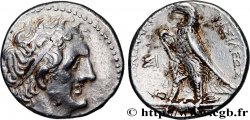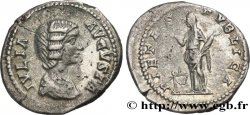v23_0332 - OCTAVE ET JULES CÉSAR Sesterce ou dupondius, coupé en deux (GB, Æ 31)
MONNAIES 23 (2004)
Prezzo di inizio : 150.00 €
Valutazione : 250.00 €
Prezzo realizzato : 150.00 €
Prezzo di inizio : 150.00 €
Valutazione : 250.00 €
Prezzo realizzato : 150.00 €
Tipo : Sesterce ou dupondius, coupé en deux (GB, Æ 31)
Data: 38 AC.
Nome della officina / città: Rome ou Italie
Metallo : bronzo
Diametro : 31 mm
Asse di coniazione : 10 h.
Peso : 11,41 g.
Grado di rarità : R1
Commenti sullo stato di conservazione:
Jolie patine verte. Témoignage intéressant
N° nelle opere di riferimento :
B.101 - RPC.621 - BMC/RR.108 - CRR.309 - RCV.1570 (1040$) - CRI.309 - C.95 - MRR.1685 (600€) - RRC.535 /2
Diritto
Titolatura diritto : [CAESAR] -DIVI. F..
Descrittivo diritto : (Têtes nue d’Otave à droite).
Traduzione diritto : “Caesar Divi Filius”, (César le divin fils).
Rovescio
Titolatura rovescio : DIVOS/ [IVL]IVS.
Descrittivo rovescio : (Tête laurée de César à droite).
Traduzione rovescio : “Divos/Iulios”, (du divin Jules).
Commento
Pour cette série, les auteurs du RPC ont répertorié 62 pièces avec vingt-et-un coins de droit. Ce type de monnaie se rencontre rarement coupé ; le fait qu’il y ait deux têtes, une de chaque côté, en est peut-être la cause. En revanche, en Gaule nous avons de nombreux exemples de pièces de Vienne, Lyon, Orange ou Nîmes qui sont coupées, mais les deux bustes sont toujours au droit.
For this series, the authors of the RPC listed 62 coins with twenty-one obverse dies. This type of coin is rarely found cut; the fact that there are two heads, one on each side, is perhaps the reason. On the other hand, in Gaul we have numerous examples of coins from Vienna, Lyon, Orange or Nîmes which are cut, but the two busts are always on the obverse
For this series, the authors of the RPC listed 62 coins with twenty-one obverse dies. This type of coin is rarely found cut; the fact that there are two heads, one on each side, is perhaps the reason. On the other hand, in Gaul we have numerous examples of coins from Vienna, Lyon, Orange or Nîmes which are cut, but the two busts are always on the obverse








 Segnalare un errore
Segnalare un errore Stampate la pagina
Stampate la pagina Condividi mia selezione
Condividi mia selezione Fai una domanda
Fai una domanda Consegnare / vendere
Consegnare / vendere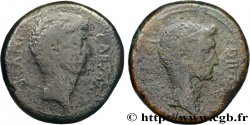
 Descrittivo
Descrittivo